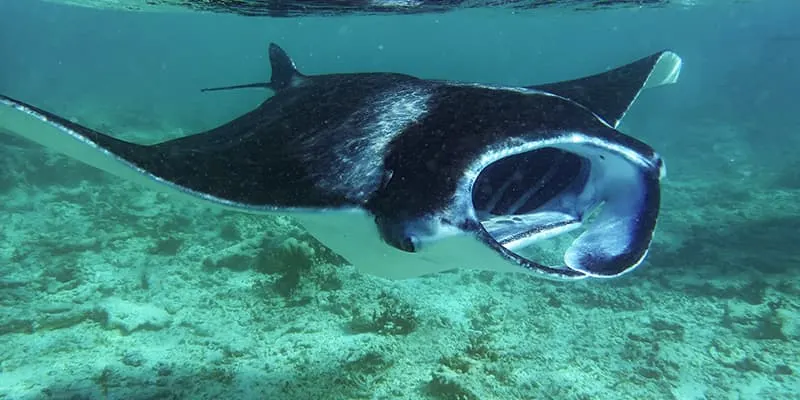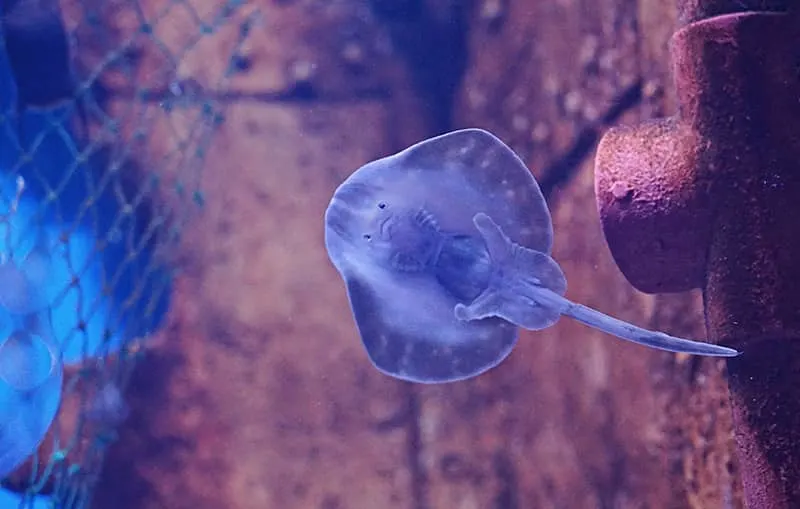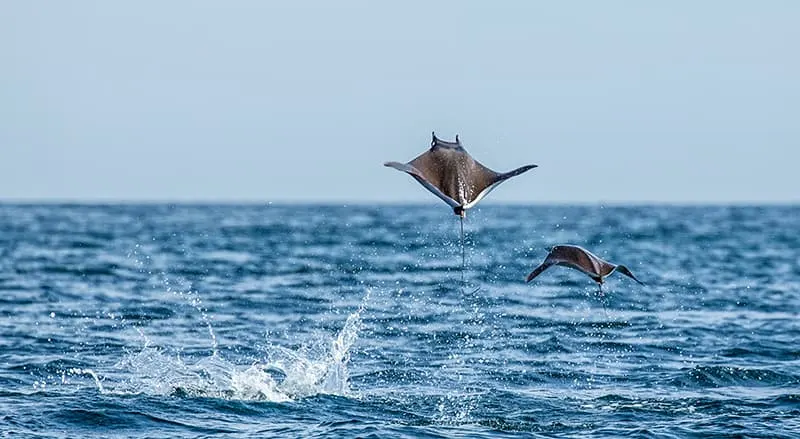Do you want to learn some interesting manta ray facts for kids? You’ll find them in this post. We’ll talk about their physical description, diet, offspring, and more!

There are two species of manta ray. The two species are giant manta rays and reef manta rays. Read here to learn about the three main differences between the two species.
This article will focus on the reef manta ray species.
Physical Description
Manta rays have wide heads and flat bodies. The body of a manta ray is shaped like a diamond. Manta rays have two flat, massive, triangular-shaped fins. These fins look like big, flapping wings. These are the pectoral fins. There is one pectoral fin on each side of a manta ray’s body.
A manta ray has two eyes located on each side of its head. It also has two fins that stick out from the front of its head that resemble horns. These are called cephalic fins. A manta has a long tail that looks like a whip.
Manta rays are measured by their disc size due to their shape. A reef manta ray’s average disc size is about eleven feet. Mantas typically weigh almost three thousand pounds. Female manta rays are usually larger than males.
Manta rays are typically black and white or all black. The black and white mantas have black tops and white bellies with dark spots. Some manta rays are completely black. There are a few white manta rays, and one pink manta ray has been seen. White and pink manta rays are rare.
Habitat
Reef manta rays are found throughout the shallow coastal waters of the Indo-Pacific region. They live in the tropical and sub-tropical waters of the Indian and Pacific oceans.
Reef manta rays can be seen in bays and around offshore islands near coral and rocky reefs.
Habits
Reef manta rays are active both during the day and at night. They stay near the surface during the day, and dive deeper at night for food. Manta rays travel short distances away from the reef to feed. They swim around with their mouths wide open, sifting plankton with their modified gills.
Manta rays have an important relationship with coral reefs. Wrasse fish that live in coral reefs clean manta rays of parasites and dead skin. Manta rays stop by the Wrasse “cleaning stations” on a regular basis. Wrasse and manta rays have a symbiotic relationship. Wrasse receive nourishment while providing a helpful cleaning to the manta rays.
Scientists don't fully understand manta rays, but they believe manta rays have social groups. Manta rays form social groups for different reasons. The most obvious reason they form groups is to catch prey and gather at the cleaning stations. Read the infographic about manta ray social groups here.

Diet
Reef manta rays are carnivorous. They are also opportunistic feeders. They eat whatever they find. A reef manta ray’s diet consists primarily of plankton, small fish, and small shrimp. They also eat fish larvae and sea worms.
Offspring
Every three to five years, reef manta rays court at “cleaning stations” to breed.
Female manta rays normally give birth to one pup every two to five years.
Manta rays are oviparous. The mama manta ray carries the egg inside of her body. After roughly a year, the pup emerges from the egg. The mama manta ray gives birth to the pup after it hatches. When the pup is born, its wings are folded around itself. It looks like a burrito. The pup quickly expands its wings and begins to swim.
When a manta ray pup is born, it has a two-to-three-foot wingspan. Reef manta ray pups are completely self-sufficient when they are born. They can eat and defend themselves. Some manta pups have been seen to stay close to their mothers for a period of time.

Classification/Taxonomy
Kingdom: Animalia
Phylum: Chordata
Class: Chondrichthyes
Order: Myliobatiformes
Family: Myliobatidae
Genus: Manta
Species: Mobula alfredi
History
Scientists estimate that rays evolved from sharks about one hundred and seventy million years ago. The ancestor of manta rays developed about twenty million years ago. Manta rays, as we know them now, emerged about five million years ago.
Predators
Due to their size and speed, reef manta rays have few natural predators. Manta rays are preyed upon by large sharks such as tiger sharks and bull sharks. Orca whales are the other main predators of manta rays.
Lifespan
According to available research, reef manta rays live to be at least fifty years old. Manta rays are rarely found in captivity. However, one manta ray in captivity lived to be twenty-three years old.

25+ Manta Ray Facts for Kids
- The scientific name of a reef manta ray is Mobula alfredi.
- Reef manta rays are listed as “vulnerable” on the IUCN Red List.
- In Spanish, “manta” means “blanket” or “cloak,” which is a good way to describe the manta ray.
- Scientists don't understand why manta rays leap out of the water.
- Manta ray spots are like fingerprints in that no two patterns are the same.
- Manta rays don’t sting and are harmless to humans.
- Manta rays are also called “devilfish” because the two fins on their heads look like horns.
- Manta rays and devil rays are two different species.
- A group of manta rays is called a squadron.
- Manta rays were separated into two species in 2009.
- Manta rays hunt using both sight and smell.
- Reef manta rays must continue to swim and move to breathe.
- Manta rays don't sleep.
- Manta rays can collect plankton by somersaulting backwards, then swimming in a circle.
- Manta rays will sometimes line up to feed on plankton. The next manta catches whatever plankton the front manta missed.
- Manta rays work together to catch plankton by swimming in a circle and creating a cyclone. This vortex draws plankton directly into the manta rays’ mouths.
- Manta rays can swim up to 22 miles per hour.
- Manta rays are very intelligent and have a good long-term memory.
- Manta rays have the largest brains of any fish, in proportion to their body size.
- Manta ray wings are formally known as pectoral fins.
- Manta rays don't have teeth.
- Manta rays are filter feeders. Their gills and gill rakers in their mouths collect plankton from the water.
- Manta rays don't have barbs or stingers on their tails.
- Manta rays aren't aggressive; they don't attack people.
- Manta rays don’t use their tails to shock people.
- Manta rays do not need their tails to swim.
- Manta rays don't bury themselves in the sand like stingrays do.
We hope you liked learning all about Manta Rays! Did you discover anything new? Let us know if you know any other fascinating facts about them. We can’t wait to find out more.
